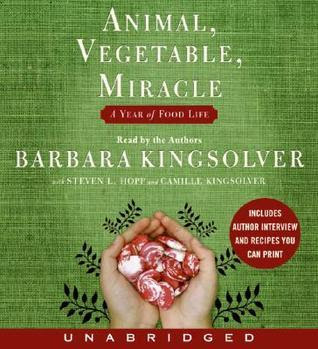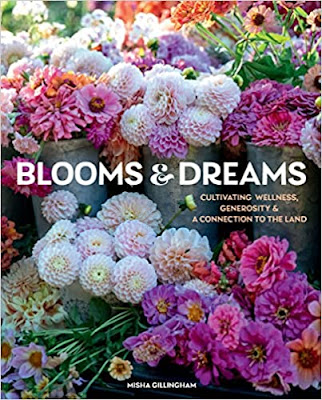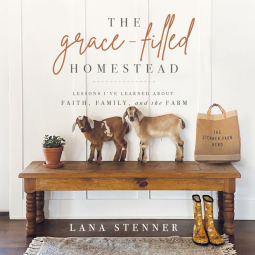Homesteading is a movement focused on self-reliance and often uses environmentally sustainable methods. While homesteading may bring forth thoughts of the 1800s when homesteaders went west, modern-day homesteaders don't necessarily live on large farms - there are urban homesteaders in apartments, suburbanite homesteaders on an acre or less (and some deal with HOAs), and there are the rural homesteaders on small hobby farms. It's really about doing something at "home in"stead" of at the store, restaurant, etc. I belong to a ladies homesteading group and my homesteading efforts are more focused on cooking and home improvement projects.
If you are homesteading or interested in this movement, I have three book recommendations that will inspire and instruct.
Amazon affiliate links are used on this site. A free audiobook of The Grace-Filled Homestead and a free ebook of Blooms & Dreams were provided for an honest review.
Animal, Vegetable, Miracle by Barbara Kingsolver, Steven L. Hopp, and Camille Kingsolver
 |
| April 2007; HarperAudio; 9780060853570 audio (14h 35m), ebook, print; nonfiction |
A friend in my homesteading group recommended this book to me. My local library had a print copy so I checked it out. I didn't have any luck finding the time to read it though and after renewing it twice (meaning I had it for 6 weeks) I had only read 4 chapters so I requested the audiobook. The audiobook is narrated by the authors and made it feel more like a conversation.
The majority of the narrative is written by Barbara Kingsolver but just as the commitment to eating local for a year was a family endeavor so is the book. Barbara provides the day-to-day operations of homesteading - planning a garden, raising the chickens and turkeys, making cheese, etc. While her section provides useful information it is presented in a way that is more like a memoir. As she shared successes, and failures, of their year of living off the land, so to speak, it often felt like journal entries. I felt inspired to be more conscientious about my food choices.
Her husband Steven provides a global view of sustainability and has a more clinical approach. His short insights are more like articles and range from international food security to factory farming to GMOs. A lot of what he touches on were topics covered by my conservation ecology and sustainable agriculture graduate courses. So for me, I didn't really learn anything new - maybe some updated information. But if you are new to homesteading or the local food economy, then you will find these sections informative.
Camille is Barbara's college-age daughter (or was at the time of the writing). She studied nutrition and offers information about meal planning and recipes. She also shares the difficulties and opportunities she had while at college during the family's year-long challenge of eating local. Her sections were largely instructional given the meal plan examples and recipes.
There were times while I was reading/listening to the book that I felt guilty because I knew that my choices were contributing to the ongoing unsustainable practices of agriculture. But as a single person, it is hard to grow enough vegetables or raise your own livestock - there just isn't enough time. While listening to the book, I wondered if Barbara realized just how privileged she was to even be able to consider trying this experiment. The farm was already in their family and she was able to stay home to tend to the gardens and animals. There was some indication towards the end of the book that she might realize it. I liked that she gave a breakdown of how much money was spent on eating locally and she did try to incorporate the cost of raising their own chickens and vegetables into the amount per meal calculations. But I would have liked to have seen some upfront costs and weekly costs calculations to know if it is truly sustainable for someone on a fixed income or who lives paycheck to paycheck and that $25 chicken at the farmer's market is their whole weekly food budget.
From the advice she gives towards the end of the book, I don't feel like she was advocating for an extreme, long-term adherence to local eating, but more so encouraging us to consider our day-to-day choices and making more sustainable and conscientious decisions when possible. The family didn't give up coffee even though coffee beans do not grow in Kentucky.
If you are interested in sustainable agriculture, supporting local small farms, or wanting to improve your diet through better quality foods, then this is an informative book to pick up.
Buy Animal, Vegetable, Miracle at Amazon
Blooms & Dreams by Misha Gillingham
 |
| August 2022; Gibbs Smith; 978-1423660200 ebook, print (208 pages); garden pictorial |
The tagline of Bloomds & Dreams is Cultivating Wellness, Generosity & Connection to the Land. Gillingham gave up the fast life of a luxury travel writer and bought a 10 acre farm on Bainbridge Island in Washington state with her family. A small portion is wooded but most of it was ready for cultivation.
This is more of a coffee table book as it is filled with more pictures and less text. Of the three books on this list, I found this one to be more inspirational than informative or instructional. If you enjoy touring farms or gardens then you will enjoy this book as that is largely how Gillingham lays out her family's homesteading journey.
If you are buying the ebook, don't read it on your Kindle Paperwhite - you will miss out on the full-colored photos that are the centerpiece of this book.
There are some instructional bits as she does go into some detail about how they designed their outdoor "rooms".
While they do have a vegetable garden, which she refers to as the Giving Garden as they donate much of what they grow to the local food pantry, Gillingham is a flower farmer. This is a growing area of homesteading where instead of growing plants for culinary or medicinal purposes you are growing them for their beauty. The flower farmers I know in my area are a source of locally grown blooms for florists and wedding planners. In an increasingly urbanized society, flower farming plays an important role in maintaining ecological balance. No longer do we have fields of flowers to support the multitude of pollinators and insects we depend on for crop pollination and other ecological processes.
Unfortunately, Gillingham doesn't take the opportunity to mention any environmental benefits, which is one of the reasons why I do not consider this a very informative book. Another reason is she doesn't mention any benefits of planting native or heirloom plants - nor is there evidence that she is purposefully planting natives and heirlooms. For her, it does seem the prevailing criterion is aesthetics. There is nothing wrong with planting for beauty, but I think it is important to note that if aren't careful you would be doing more harm to the environment. Like when everyone wanted to help monarch butterflies so started planting milkweed, but not necessarily the native variety and some of the non-native varieties can actually harm the butterflies.
She encourages the reader to be generous with their bounty. Gillingham and her family seem fortunate enough not to need the farm to support them. That is evident in the fact that they keep livestock though not for meat or milk. I'm glad that they are able to donate their surplus, but most homesteaders I know sell their surplus in order to financially support their homestead. Yet, homesteaders are some of the most generous people I know. They are usually the first to lend a hand when someone needs a fence fixed or extra hands for chicken processing or providing a meal when a family experiences a death or serious illness. So if you are wanting to practice generosity but still need to support your homestead, keep in mind that there are many ways to show generosity - you don't necessarily have to donate vegetables from your garden to the food pantry or provide a recreational arena for your community.
If you are looking for some inspiration for your homesteading journey or enjoy farm tours to see what others are doing, then this is a great book for that.
Buy Blooms & Dreams at Amazon
The Grace-Filled Homestead by Lana Stenner
 |
| September 2022; Dreamscape Media; 9781666613179 audio (3h 35m), ebook, print; nonfiction |
The Grace-Filled Homestead, as stated in the tag line, is about the lessons Lana Stenner learned about faith, family, and the farm. The audiobook is read by Stenner herself so it feels more like a conversation.
I found this short audiobook to be pretty instructional with its "homestead how-to" and "from the recipe box". I so wished I had read this book before I tossed out my old bookcase. The shelves had fallen apart but the rest of it was in great shape, I just couldn't think of a use for it. In one of the how-tos, Stenner told how she repurposed an old bookcase into a raised garden bed.
I liked that she considered that homesteaders come in all land sizes - apartment dwellers to 40-acre ranches. And encouraged the reader to do what they could with what they got.
There are a few faith-based objects lessons that were just too ripe to pass up. While Stenner is a Christian and the object lessons are in terms of her relationship to God, they are also good life lessons. These stories are shared as part of her life and not overtly to evangelize.
I started this list with a book that at times made me feel guilty, this book had me feeling hopeful and uplifted. Stenner is inspiring in her homesteading journey and her story is quite uplifting. I've been struggling with homesteading on my own, and while Stenner does have a husband that helps her, I felt encouraged after listening to this audiobook.
If you are looking for an instructional read that is also inspiring and leaves you feeling encouraged, then this is the book to pick up.
Buy The Grace-Filled Homestead at Amazon
Donna Huber is an avid reader and natural encourager. She is the founder of Girl Who Reads and the author of how-to marketing book Secrets to a Successful Blog Tour.
Enjoyed this post? Never miss out on future posts by following us. Get even more book news in your inbox, sign up for our newsletter today! Girl Who Reads is an Amazon advertising affiliate; a small commission is earned when purchases are made at Amazon using any Amazon links on this site. Thank you for supporting Girl Who Reads.




.png)
















Great reviews, Donna! I'll need to look into that repurposing a bookshelf:)
ReplyDelete